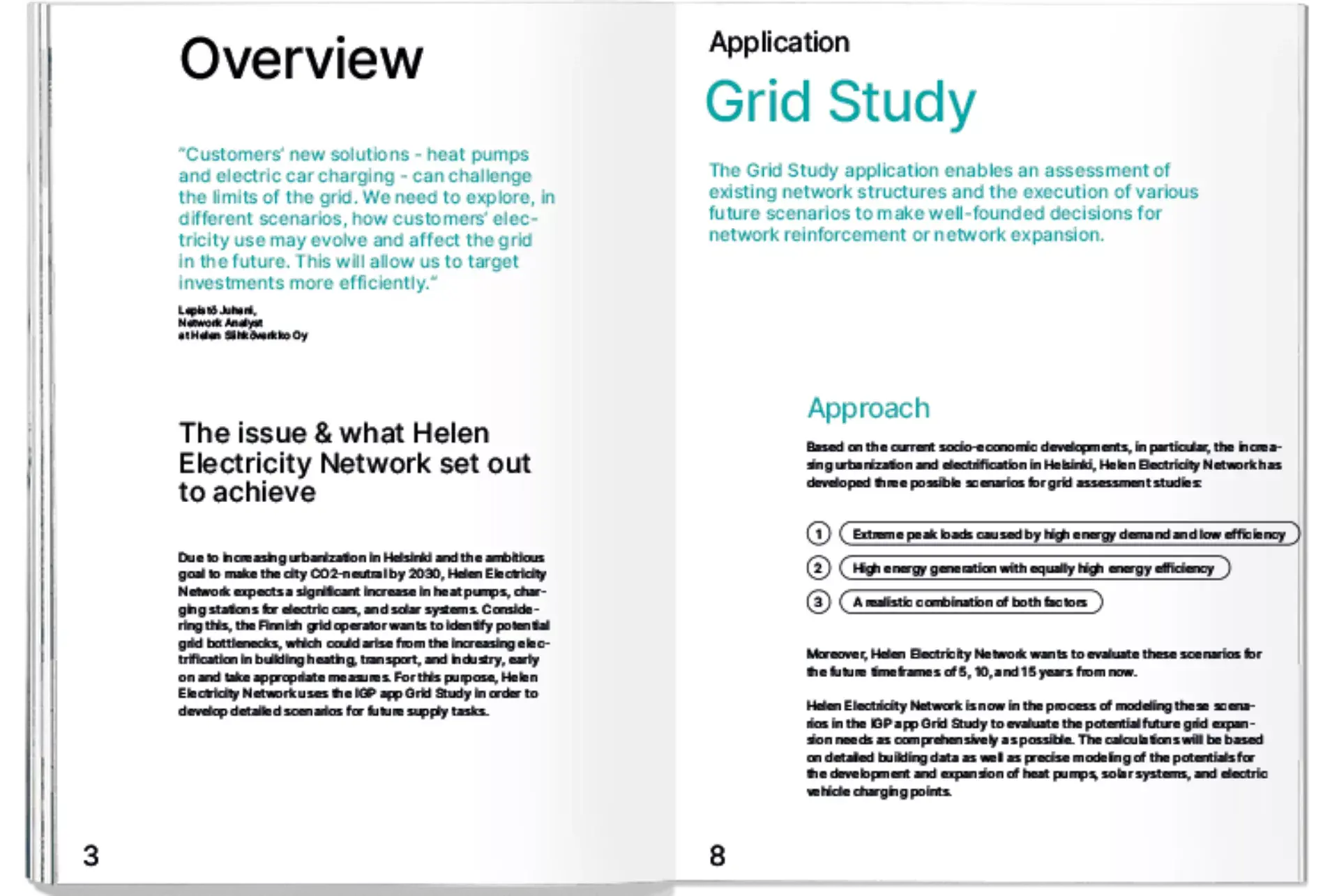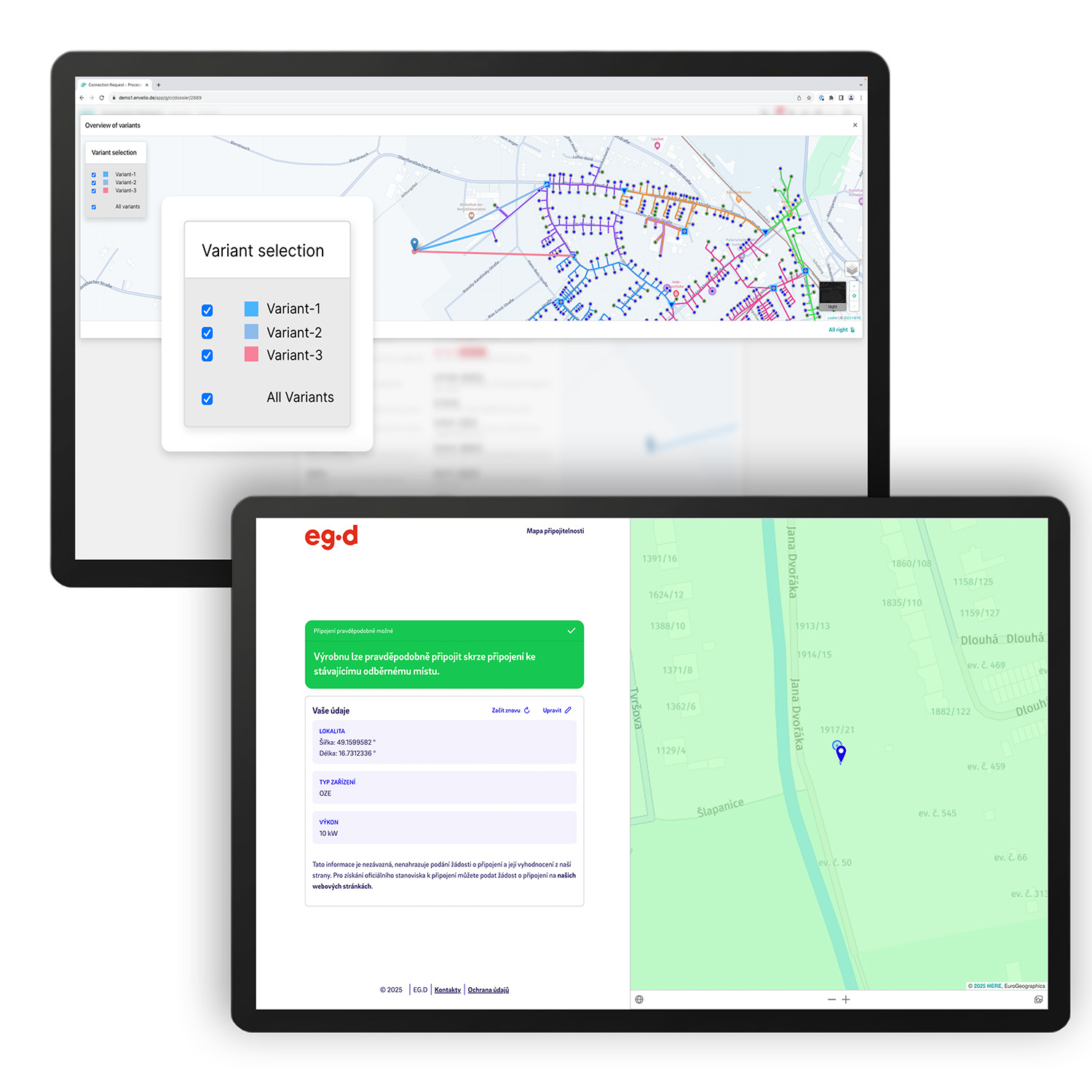.png) Play Video
Play Video
Valid Grid Studies
and Investment Planning
The Basis for Effective
Network Development Plans

Sweden’s electricity demand is expected to more than double by 2050, reaching over 300 TWh compared to today’s 140 TWh, as highlighted in a study by Uppsala University. As a result of an increasing number of industry transition projects, demand projections from various stakeholders are also increasing rapidly.
At the same time, renewable energy is experiencing virtually unlimited growth. But how will these new generation units and loads impact the grids? Are the capacities of the installed assets sufficient? Where are bottlenecks likely to occur? Where, when, and how can the grid be reinforced as cost-efficiently as possible?
To answer these questions reliably and future-proof the grid, a robust strategic grid planning process is essential. This includes:
- Developing scenarios for future supply tasks
- Assessing the concrete impact on the grid
- Creating an investment plan for the grid
NIS “on steroids”: How DSOs Can Unlock More from Their Grid Information System Data
If you're looking for practical examples, it's worth taking a look at neighboring countries – Finland, for instance. Helen Group, a major player in the Finnish energy sector, is responsible for providing energy and heating services in the Helsinki region. Like many other European countries, Finland is increasingly focusing on the decarbonization of the transport and building sectors, leading to a rapid growth in EV charging points and heat pumps.
These requirements make automated, transparent grid planning essential – yet current systems are often still cumbersome and time-consuming. In the project with Helen, full models of the regional and local distribution grids were prepared in the envelio IGP.
Data from the NIS (Network Information System) was integrated and combined with information from the MDMS (Meter Data Management System) to include time series and smart meter data in the planning processes. The entire onboarding and interface development was managed by envelio’s data engineering team with minimal effort required from Helen. Another key feature of the Intelligent Grid Platform (IGP) is the ability to perform N-1 contingency analysis.
”This will allow us to target investments more efficiently.“
”Customers‘ new solutions - heat pumps and electric car charging - can challenge the limits of the grid. We need to explore, in different scenarios, how customers‘ electricity use may evolve and affect the grid in the future. This will allow us to target investments more efficiently.“
Juhani Lepistö
Network Analystat Helen Sähköverkko OyCase study: Helen Electricity Network
Running future grid scenarios to determine the probability of bottlenecks
To identify potential grid bottlenecks early and implement suitable measures, Helen uses the Grid Study app. This allows them to develop detailed scenarios for future supply tasks. The main goals were:
- Evaluate various grid scenarios for potential future bottlenecks & limit violations due to increasing electrification
- Determine how probable these bottlenecks and/or violations are and when they will occur
- Identify the potential need for grid reinforcement to ensure future supply reliability
- Enable the general planning team to harmonise possible grid reinforcement needs with other needs
- Derive data-driven investment decisions based on the results of the grid scenario evaluations
You can find more insights and results in the Helen case study and how they leveraged the Intelligent Grid Platform to achieve their goals.

New Obligations for DSOs in Sweden
Obligation for Network Development Plans
Starting in 2025, distribution grid operators (DSOs) will be required to submit network development plans every two years. These plans must include investment strategies and capacity assessments for the upcoming 5 to 10 years. Below you will find all requirements summarized at a glance:
- Frequency: Mandatory every 2 years
- Start year: 2025
- Horizon: 5-10 years ahead
- Grid included: Regional and local distribution grids
- Legal framework: EIFS 2024:1
- Regulatory authority: Energy markets inspectorate (Ei)
The aim of the legislation is to consolidate the plans to show stability and flexibility services that are needed. Ei has the mandate to demand changes to a submitted plan, as well as DSOs can change their submitted plan. Furthermore, the plans are not legally binding.
To implement these legal requirements in a reliable and professional manner, the following are needed:
- Grid capacity prognosis based on demand and production including assumptions and drivers for most probable development
- Account for planned investments and how flexibility services as an alternative to capacity increase has been considered
- Follow-up of previous plans and account for how cooperation with other actors has been considered
- Expected capacity situation and evaluation if planned activities are sufficient to meet the demand and how capacity constraints to overlying grid are to be addressed
- A particular weight is added to main distribution infrastructure that is needed to connect production capacity and consumers including charging infrastructure for EVs
Long-Term Planning and Scenario Analysis: Key Challenges for DSOs
Long-Term Planning and Scenario Analysis: Key Challenges for DSOs
The ability to create and simulate scenarios is becoming essential for DSOs in Sweden, especially for consistent investment planning. However, many DSOs face challenges due to insufficient data or lack of tools to evaluate existing data. The main barriers include:
- Poor data quality on grid infrastructure and customers
- IT system silos with little communication or integration, requiring manual data transfers
- Inconsistent use of available sensor data in simulations
- Limited ability to run mass simulations across multiple networks and scenarios
- Failure to account for changes in user behavior due to flexible loads and dynamic tariffs
Additionally, traditional NIS and grid calculation tools lack sufficient capability for comprehensive scenario analysis, making it nearly impossible to simulate widespread structural impacts in detail.
Current methods can evaluate only a few scenarios and involve significant manual effort. This makes it difficult — or even impossible — to analyze the impacts of new connection types (DER, storage, etc.) and the role of flexibility in grid development.
More than 50 % investment savings

“Insights from our customer projects indicate that deploying smart grid assets can reduce investment expenditures by as much as 50 % compared to traditional grid expansion.”
Dr. Tobias Falke
VP Global Sales & Marketing envelioReliable Grid Development Requires Valid Grid Studies and Investment Planning
To maintain long-term technical reliability, future-oriented strategic grid planning and well-founded investment forecasts are essential. Investment planning must clarify where and when reinvestments are necessary and what the electrification costs will be with and without load control.
These decisions rely on evaluating future supply scenarios. The envelio Grid Study app addresses this exact challenge: it enables you to easily create a variety of detailed scenarios for future supply tasks.
With the app, you can integrate different trend scenarios into your grid model and precisely determine future reinforcement or expansion needs.
Grid Study: Build a Better Basis for Your Network Development Plans through Easy Evaluation of Future Energy Scenarios
Another key feature of the envelio Grid Study app is the ability to carry out detailed stress tests and scenario analysis for your grid area. Create various scenarios for future supply tasks in just a few steps.
Have your forecasts automatically projected onto your own grid area and determine the effects of newly added charging stations or decentralized generating plants. Use the results to identify potential grid bottlenecks and optimize your strategic grid planning.
.png) Play Video
Play Video
Webinar: Cutting grid connection costs & time by 40%: How EG.D streamlines processes with envelio
Exclusive insights for distribution grid operators
Join this exclusive webinar with Michal Holan and Tomas Mendl from EG.D, alongside Christine Harnischmacher from envelio, as they share their experiences optimizing grid connection processes through digitalization.
Learn how they approached automation, reduced workload, and improved response times – all while maintaining operational efficiency.

FAQs
What is Strategic Grid Planning?
Strategic grid planning refers to the phase where decisions are made about which actions are needed to prepare the grid for future requirements. It includes power flow simulations, scenario analyses, and investment assessments.
What is a Scenario Analysis?
Scenario analysis is the structured examination of potential future developments and their effects on the power grid. Different trends – such as the rollout of PV systems, heat pumps, or EV charging infrastructure – are modeled and simulated to evaluate their impact on grid stability and capacity.
What is Investment Planning?
Investment planning involves determining when and where to invest in the grid based on scenario analyses and grid study results. It considers timing, costs, benefits, and urgency to make efficient investment decisions.
What is the difference between Grid Planning and Grid Development
- Grid planning refers to analysis and decision-making for future grid needs.
- Grid development is the execution of these decisions – i.e., constructing, reinforcing, or upgrading the infrastructure.
In short:
Planning = Thinking and Deciding
Development = Doing and Building
Do you have any questions?
In this case, we look forward to getting to know you and answering all your questions about our product and our company. On top of that, you’ll be able to already experience our platform live.
Don’t forget to send your request for a quick demo today.
Contact person
Dr. Tobias Falke
VP Global Sales & Marketing


